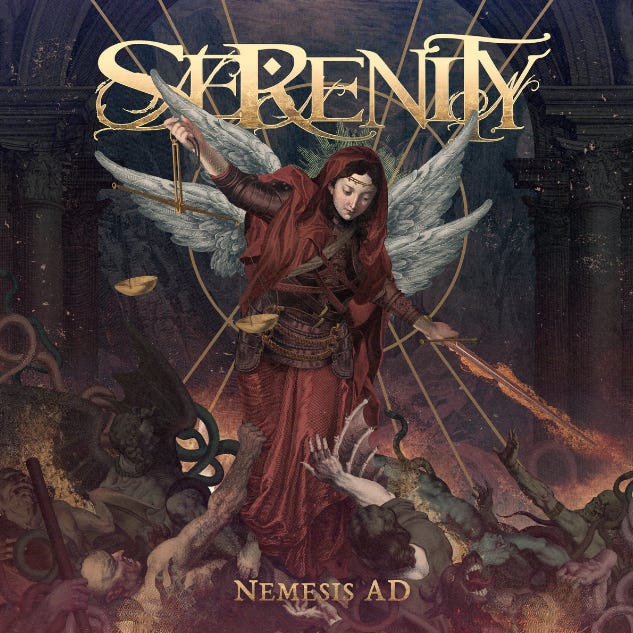Serenity is an Austrian Symphonic/Power Metal band — firmly within a favored niche for me — that I only recently learned of, despite that the band has been around for twenty years, and producing albums for fifteen.1 And it’s honestly a shame, because their sound lines up incredibly well with that of Kamelot, a band that’s been at the top of my list for roughly the same amount of time.
Naturally, I cannot attest to how long they’ve sounded like Kamelot, but this album sounds like Kamelot.2
In fact, I have to stress that their sound is a dead ringer for Kamelot to the point that vocalist Georg Neuhauser is a sound-alike for Kamelot’s vocalists, right down to his vocal style. This is so notable because Roy Khan3 is featured in the album’s opening song, “The Fall of Man”; his is a voice I am incredibly familiar with, but I can only be about 90% certain as to which voice is his throughout. There’s always that little bit of doubt because they sound so alike.
If I’m right, though, I have to point out that Neuhauser gives the first verse to Khan, which is practically unheard of for a featured artist. I can only see it as a sign of immense respect.
“The Fall of Man” starts the album off on a Biblical note, leaning heavily on the end of the story of Adam and Eve — humanity’s ousting from Eden. And it does so with a suitably epic composition in one of the grandest tracks on Nemesis AD.
This tone is carried directly into the subsequent track, "Ritter, Tod und Teufel (Knightfall)”, which takes its name and thematic elements from the 1513 engraving by Albrecht Dürer. Translated, the title reads “Knight, Death and the Devil”.

There is one other truly standout track on the album, and it’s also the longest: “Reflections (of AD)”. This track utilizes strong melodic and symphonic elements, including Gregorian-like backing vocals, to craft an engrossing eight-minute anthem which ebbs and flows with polished intent. It is the full realization of what Serenity is capable of on this album.
Much of the rest of the album is enjoyable: “Sun of Justice” is a great execution of what any Sun God’s Paladin would consider anthemic; “The End of Babylon” is Symphonic Power at its most dramatic; “The Sky is Our Limit” is uplifting and hopeful. There’s nothing bad here, but Nemesis AD is a great example of why I like to give albums at least two full listens.
Because the first time through, I was thoroughly unimpressed. It really just felt like a copycat; a cheap knockoff of Kamelot, albeit with maybe more focus on the heavier tracks. That impression hasn’t been wholly defeated, but at least I’ve been able to identify a bit more of what makes Serenity unique in their own right. There are moments, at the least, which do not sound like alternate-universe Kamelot, most notably in tracks 3, 5, & 6. It’s not quite as uninspired as I initially thought.
And it’s good enough that it could give this year’s actual Kamelot album a run for its money.
As a whole album, Nemesis AD is doing something interesting, though. The album’s title invokes the Greek figure of Nemesis and gestures vaguely at the modern era through the inclusion of “AD” in the title. With the clearly Biblical tone set early, and Nemesis depicted as an Angel on the cover, the album seems to sit in judgment of the current state of the world. However, it only seems to be doing so in the vaguest, finger-waggingest of terms.
If there’s something more concrete here, I haven’t spotted it yet. I suspect there must be something more, because the above description still feels weak.
Still, Nemesis AD isn’t bad. Especially for fans of Kamelot who need something very similar. This one should help to scratch the itch.
But it’s never great when I spend the majority of a review talking about another band. With 15+ years of experience, Serenity should have more thoroughly defined their own sound by now.
Rating: Yellow
Their debut effort, Words Untold & Dreams Unlived, released in 2007; Nemesis AD is their 8th full-length album. I should also note that, by the time they released that debut album, only two members of the original lineup were left. Keyboardist Mario Hirzinger also left shortly before the band’s 4th album released, leaving only drummer Andreas Schipflinger from the band’s original 2001 lineup.
A little quick research indicates that they were a little more Proggy in their early years, but Kamelot also utilizes Prog elements.
Roy Khan, now 53, is best known for his tenure as the vocalist of Kamelot from 1997-2011. This 14-year period includes seven of Kamelot’s thirteen LP releases, notably The Black Halo and Ghost Opera, two of their best, and the ones I would have to credit with their sharp rise to the top of the genre. Nowadays, Khan has reunited with his original band, Conception.





